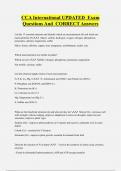Summary
Summary A Level Biology - Electrical Activity in the Heart Notes
- Module
- Topic 7 (9BN002)
- Institution
- PEARSON (PEARSON)
Detailed and comprehensive notes on electrical activity in the heart (Edexcel biology A). [“A-Level Biology: Edexcel A Year 1 & 2 Complete Revision & Practice” (CGP, ISBN: 9781782942986), “Salters-Nuffield AS/A level Biology Student Book 1” (Pearson, ISBN: 9781447991007) and “Salters-Nuff...
[Show more]












